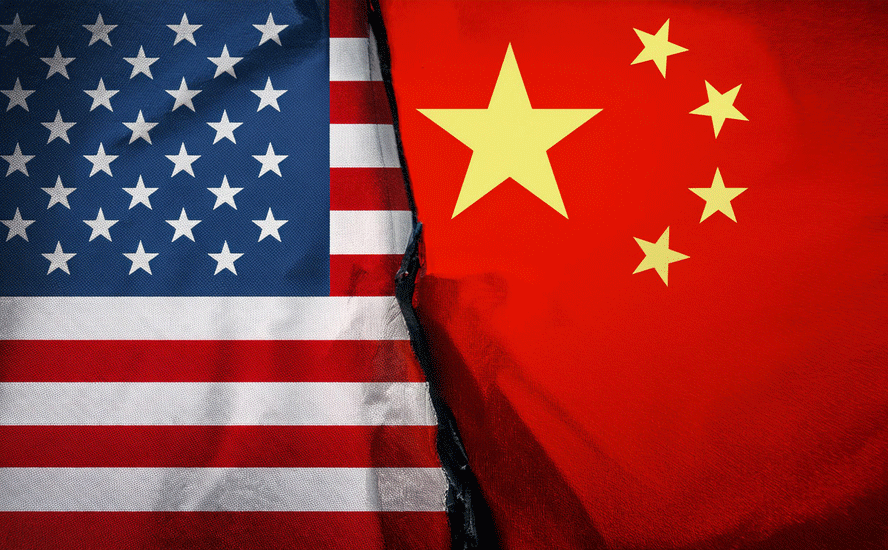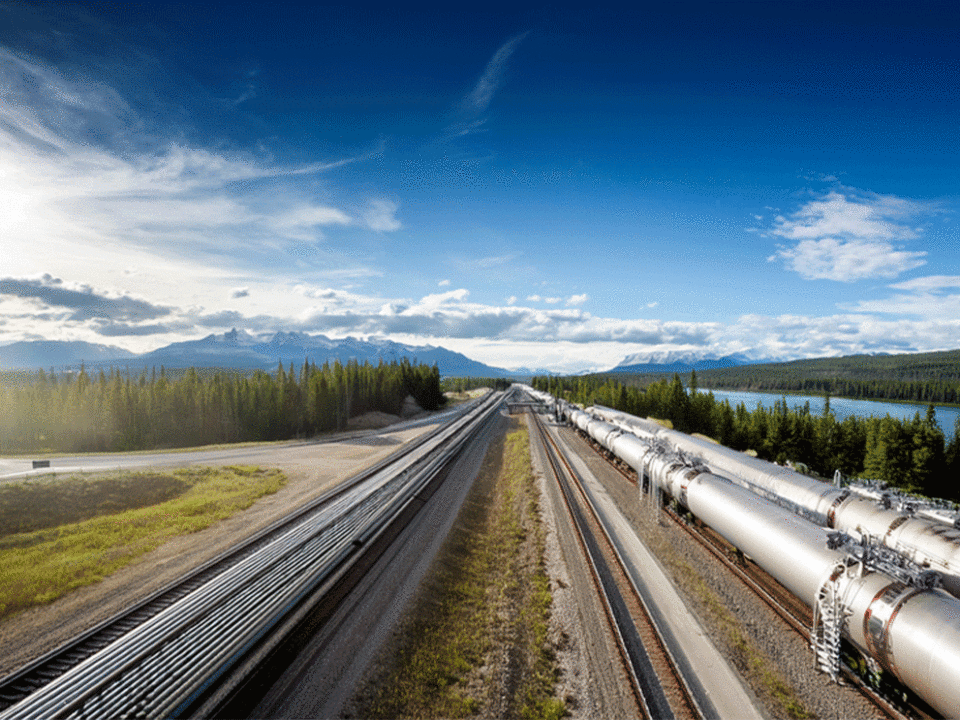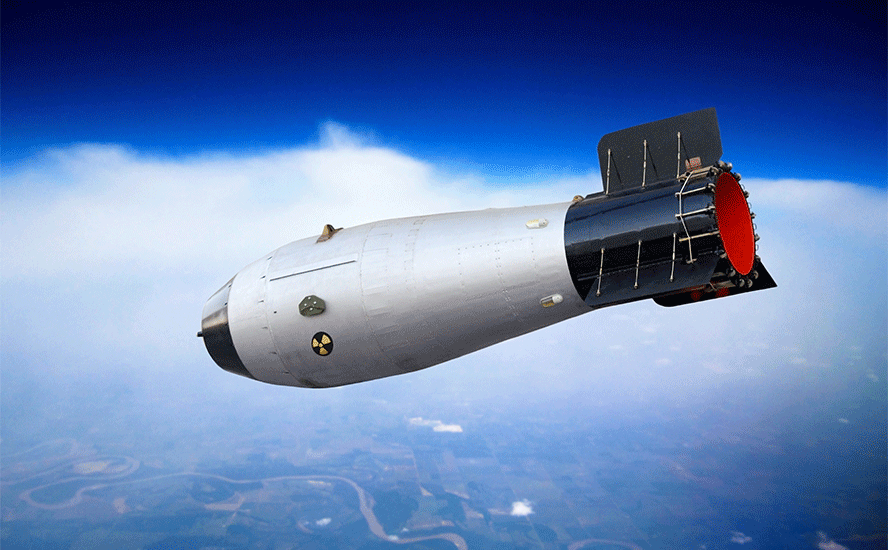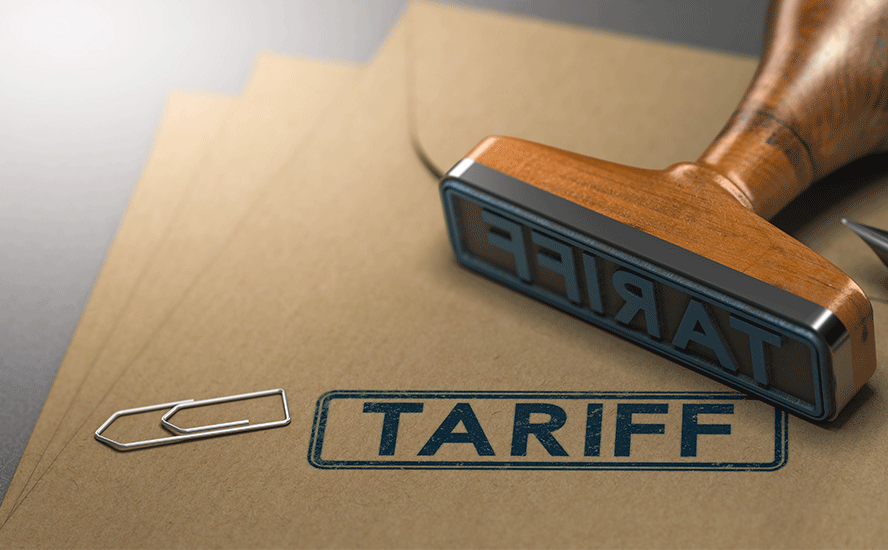The US pivot to Africa

2019.12.04
As world leaders gather in London this week for the NATO Summit, the country with the most heft is still complaining about funding allocations, as other member nations fight amongst themselves – threatening cohesion of the 29-member defensive alliance.
Meanwhile the United States appears to have shifted its gaze from Europe to Africa, not only as a region needing protection against terrorism and instability, but as a source of mineral and oil wealth ripe for extraction, as problems appear in America’s “shale revolution”.
At Ahead of the Herd we don’t believe in coincidences. In this article we’re asking, “Could US intransigence towards NATO have anything to do with its military pivot to Africa?”
Trump and NATO
US President Trump has railed against NATO, viewing it as a relic of the Cold War, since the 2016 presidential campaign.
“You know, we’re dealing with NATO from the days of the Soviet Union, which no longer exists. We need to either transition into terror or we need something else,” Trump said at the time, failing to acknowledge the help of NATO members, including Canada, in supporting the US-led war in Afghanistan.
Article 5 of NATO’s constitution states that an attack on any member is considered an attack on all the others; the only time Article 5 has been triggered was after the terrorist attacks of September 11, 2001.
The disruptive president would go on to pick a fight with Germany’s Chancellor Angela Merkel over “the vast sums” it owes NATO and that the US should not have to pay so much for its defense of Germany.
Trump has also threatened to “moderate” Washington’s commitment to NATO if members fail to meet a 2% of GDP spending target. Germany’s NATO defense expenditure as a share of GDP is 1.36% versus 3.42% from the US. Merkel has vowed to hit the 2% target by the early 2030s.
Last week, the Trump administration went a step further, stating the US will slash its 22% contribution to NATO’s overall budget to 16%, near Germany’s 14.8%.
It’s important to appreciate however that direct funding to NATO, which covers maintenance of NATO headquarters, joint security investments and some combined military operations, only amounts to about $2.5 billion. It is completely separate from the national defense budgets NATO members agreed in 2014 should be 2% of GDP (currently only eight of 29 members meet that target). NATO estimates the total spending on defense by member countries in 2019 is over $1 trillion.
Much of Trump’s arguments against NATO are economic. Despite the alliance having nothing to do with international trade, Trump has complained about how much the US spends on NATO yet has an $800 billion trade deficit.
During a 2018 rally, Trump slammed his European allies for relying on Russia for natural gas and oil imports yet the US funds their defense.
“They want us to protect against Russia, and yet they pay billions of dollars to Russia, and we’re the schmucks paying for the whole thing.” Trump’s got a point – of the hundreds of billions of dollars/ euros paid to Russia by the EU how much goes into military based expenditures by Putin? They are literally paying Russia to fight a war…against themselves, invade Ukraine and finance activities in Syria and elsewhere. Seems inconceivable any NATO country leader would tolerate this.
Ironic isn’t it? Since 2016 NATO members have upped their spending by $130 billion, mostly due to the increased threat Russia is believed to pose after annexing the Ukraine.
‘Brain-dead’ NATO
Donald Trump isn’t the only Western leader to take a shot at NATO. France’s President Emmanuel Macron has been vocal about member countries carrying out their own military missions and decisions without regard to NATO.
“You have partners together in the same part of the world, and you have no coordination whatsoever of strategic decision-making between the United States and its NATO allies. None,” Macron said via Germany’s DW, adding “Strategically and politically, we need to recognize that we have a problem.”
In particular he pointed to Turkey, a NATO member, attacking the Western-allied Kurds that helped defeat the Islamic State in Syria, and the US decision to without troops from Syria without consulting its NATO allies.
“What we are currently experiencing is the brain death of NATO,” Macron said when interviewed by The Economist. He doesn’t want the NATO Summit to be dominated by military spending. Rather, Macron prefers to discuss where NATO is going, who its adversaries are and what to do about Turkey, Toronto Star reported.
The country whose largest city Istanbul has, for hundreds of years, been considered the “gateway to the East,” is also planning to test a new air defense system it purchased from Russia, NATO’s main adversary.
Beefing up bases
The US Military insists that it maintains a “light footprint” in Africa, especially since four US servicemen were killed in a 2017 ambush in Niger. In fact, the military has been quietly beefing up its presence on the continent ever since the 2012 attack on the US mission in Benghazi, Libya that killed the US Ambassador and three US nationals.
A 2017 report by CBS News states there are roughly 6,000 military personnel spread across the African continent including 800 temporarily deployed to Niger.
The most heavily defended nation is Djibouti, across the Gulf of Aden from Yemen, where Camp Lemonnier is the only permanent US base in Africa.
Amid US Military reports of downsizing special operations forces and closing outposts, documents from US Africa Command (AFRICOM), obtained by The Intercept, instead show the opposite, with modest cuts to personnel and no base closures planned. Camp Lemonnier for instance has expanded from 88 to about 600 acres since 2002.
According to the Pentagon, AFRICOM’s network of 34 bases across 24 countries includes 14 larger and more permanent “forward operating sites”, and 20 “cooperative security locations”. Officially, CSLs are neither “a US facility or base”. AFRICOM has downgraded their importance as small, temporary and little more than local bases where Americans are tenants to the host country.

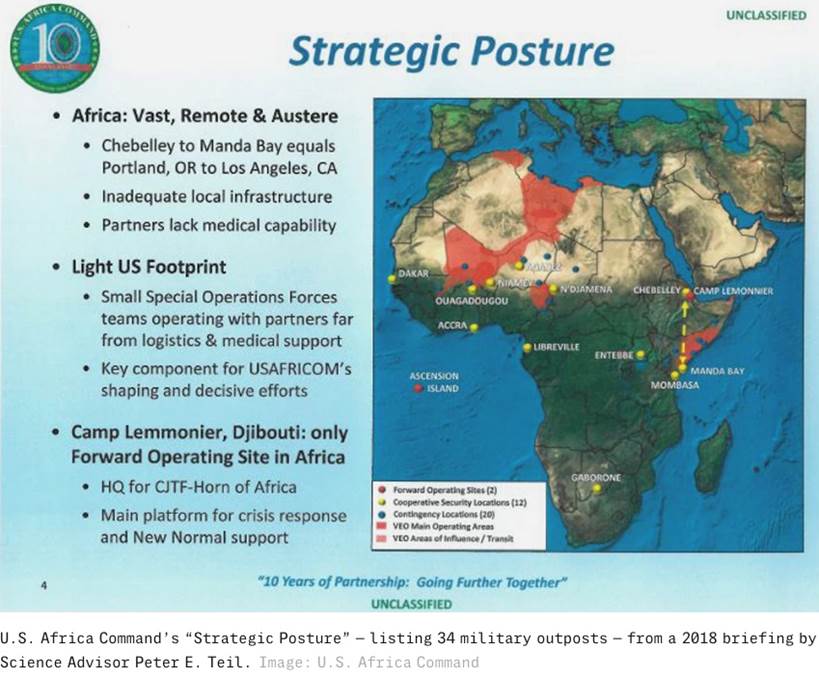
However it is through these smaller, “lily pad” locations that the military is strengthening its hold on Africa. In Niger, the military’s five sites, including two CSLs, are the most of any foreign power in West Africa. While China, Russia, France and the United Arab Emirates have increased their African engagement over the past few years, none approaches America’s footprint.
A drone base known as Nigerien Air Base 201 has a construction budget of $100 million but with operating expenses is expected to cost US taxpayers over a quarter billion dollars by 2024 when its 10-year agreement ends, states The Intercept.
The largest drone complex in the world in Chabelley, Djibouti – where China hosts its one and only overseas base – is involved in wars in Yemen and Somalia. An even larger drone base is reportedly being built in Agadez, Niger.
A 2016 story in the Washington Post cites a decision by the Pentagon to secretly deploy unmanned aircraft and military personnel to a facility in Tunisia, to spy on ISIS in neighboring Libya. At the time, North Africa was Islamic State’s largest base of operations outside Syria and Iraq.
The action was part of a broader Middle East security strategy by the Obama administration to place drones and small operations teams at facilities within striking distance of militant groups that may pose a threat to the West – such as ISIS, Boko Haram and al Qaeda.
Apart from the need to conduct surveil and possibly attack, by unmanned aircraft, such militants, there are other reasons for US military expansion in Africa.
Counter-punch
Foremost is the need to counter Russian and Chinese influence and access to resources in the region. As we have reported, China has been mining Africa since at least the early 00’s, when China’s state-owned enterprises (SOE) and sovereign wealth funds (SWF) were sent out to scour the globe for resources – to fuel China’s exploding economy.
In under 10 years, the number of China-headquartered mining companies with assets in Africa went from just a handful in 2006, to 120 in 2015. Two high-profile examples are the acquisition, by China General Nuclear Power Corporation, of the Husab uranium project in Namibia, and Zijin Mining’s involvement (39.6%) in the massive Kamoa-Kakula copper deposit in the DRC.
While iron ore and copper have been the hot targets of overseas acquisitions by Chinese firms, the Chinese have also gone after gold, nickel, tin and coking coal.
More recently the most desired metals are those that feed into the tectonic global shift from fossil fuels to the electrification of vehicles.
For example, China Molybdenum bought the Tenke copper and cobalt mine in the Democratic Republic of Congo for $2.65 billion in an effort to secure a supply of cobalt for EV batteries. China also purchased a 23.7% stake in Chilean state lithium miner SQM, from Canadian fertilizer giant Nutrien, for an eye-popping $4 billion. With operations centered in Chile’s Salar de Atacama, SQM is the second-largest lithium mining company in the world.
As for Russia, its only base is in Eritrea. The country is strategically located on African’s eastern edge, across from the Arabian peninsula. From there Russia is building on historic alliances with countries like Libya, to ensure access to the southern Mediterranean.
Military Times quotes Jack Reed, a Rhode Island senator, saying that The Russians are also forging new partnerships in places like the Central African Republic to secure resources and gain new allies, “which seems to be an attempt by Putin to return to great power influence that they enjoyed over the Soviet Union.”
Indeed the Kremlin has its eye on Africa’s rich natural resource bounty. This includes interest in Niger’s uranium to develop nuclear power, as France has. According to The Duran blog, private military contractors working for Russia have been hired to protect resources in six countries including:
- Central African Republic (gold, timber, diamonds)
- Libya (oil, natural gas, iron ore)
- Mozambique where Russia’s Gasprom was competing for a large natural gas contract awarded to ExxonMobil
- Angola (iron ore, diamonds, petroleum, bauxite, uranium, feldspar and petroleum)
- Uganda (copper, cobalt, gold, platinum)
- Cameroon (oil, timber, hydroelectric power, rubber, palm oil, natural gas, cobalt, nickel)
Oil and gas prize
The United States of course is looking to lock up resources of its own just as China has done on the continent. Most important are Africa’s oil and gas assets.
Consider that until quite recently, the Middle East was America’s top supplier of oil. Recall the OPEC oil embargo of the 1970s and how that affected US motorists. These days the gasoline in your tank is more likely to have originated from crude oil in Canada or Latin America. Last year a whopping 43% came from Canada, with Saudi Arabia shipping 9% and Mexico 7%. Venezuela sent 6% and Iraq 5%.
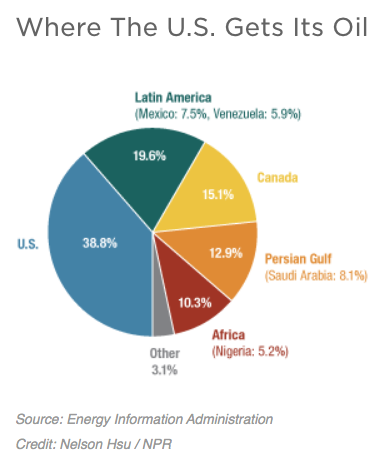
Saudi Arabia’s oil fields are depleting and America’s relationship with the Saudis is always in flux. While Trump has looked the other way as the kingdom, led by Saudi Crown Prince Mohammed bin Salman, slips farther into dictatorship, Democrat-controlled Congress is appalled at the policies of America’s staunchest ally in the Middle East. If a Democratic president is installed in the White House next year, the relationship would almost certainly not improve.
The US has imposed an embargo on Iran and Iraq is constantly under the threat of ISIS and other terrorist organizations keen to seize its oil fields.
So, with the future of Middle Eastern oil in doubt, and the engine of US oil production, shale oil, sputtering, the pivot to Africa seems to be a smart strategy.
First to the potential in Africa. It’s estimated that over half (57%) of Africa’s export earnings come from oil and gas. Al Jazeera reports that proven oil reserves have jumped almost 150%, from 53.4 billion barrels in 1980 to 130.3 billion at the end of 2012. Five of the world’s top oil-producing countries are in Africa.
US oil company ExxonMobil is one of the continent’s largest investors, having committed over $24 billion to energy exploration and development. Italy’s Eni is a close second with plans to invest $25 billion.
Earlier this year Exxon made a final investment decision regarding Mozambique’s liquefied natural gas fields. Its Rovuma LNG project, jointly operated with Eni, is expected to produce 17,000 tons of LNG per annum. The $30 billion project will produce, liquefy and sell natural gas from three reservoirs located off Mozambique’s northern coast.
A graphic below by Deloitte Insights indicates which countries are the top oil and gas producers in sub-Saharan Africa. Nigeria is the largest producer at 671.59 million barrels, followed closely by Angola at 591.6 million. Most of sub-Saharan Africa’s natural gas, 162.5 billion cubic feet, is produced in Nigeria, with Equatorial Guinea second at 336.5 bcf and Angola third at 196.8 bcf.

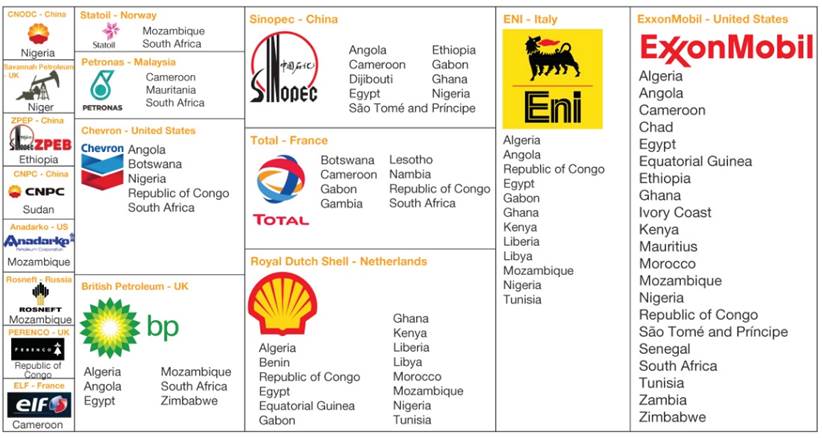
US shale drying up
The US oil industry would have us believe that production from the country’s vast shale oil fields will last another couple of decades. Nothing could be further from the truth. Two years ago we started writing about the depletion of shale oil deposits due to the “Red Queen Syndrome” – our prediction of supply peaking, of “peak shale oil” as soon as 2021, appears to be coming true. A couple of recent articles by Oilprice.com prove our case.
While most articles suggest that shale production could go on at current levels for the next 20-30 years, the evidence actually points to a leveling off of shale production, as productivity increases stop and wells are tapped out, or drilled and never completed.
Productivity data from the EIA and charted by the Financial Times shows that while production in the main shale formations grew steadily from 2007, rising sharply in 2015 (the Eagle Ford peaked at nearly 1.6 million bopd) mid-2016, from 2017-18 rates have declined. Data from Baker Hughes showed that a year-long ramp-up by US shale operators hit a plateau in July 2017, with some companies, like Pioneer Resources, lowering their targets.
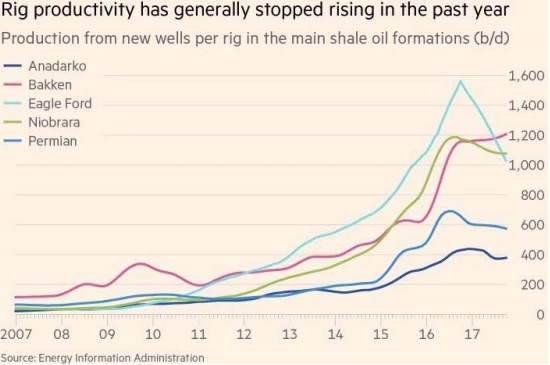
The lower numbers have some predicting that US shale oil production could peak before 2025. This is because shale oil wells are gushers in their first year, then deplete rapidly. Shale companies are therefore money losers because they have to keep ploughing more money into production just to keep output flat, a phenomenon known as “The Red Queen Syndrome.”
On Nov. 19 Oilprice.com reported that Growth in the US shale industry is dramatically slowing down, with cash-strapped drillers slashing spending and scrapping rigs.
According to the Institute for Energy Economics and Financial Analysis (IEEFA), Exxon only managed to make $39 million from its US operations during the third quarter, despite spending $3 billion, or 39% of its global expenditures! Over the past two years the oil and gas giant only earned a decent return from its US shale assets in one quarter, and that was due to the government’s $1.5 trillion tax cut.
Several shale drilling companies have gone bankrupt, with the most recent, Approach Resources, finally throwing in the towel after amassing $400 million in debt.
Even shale Pioneer Chesapeake Energy, which led drilling in the Marcellus, Barnet and Haynesville shale basins, is bending under the weight of a US$9.7 billion debt burden.
The red ink is forcing many shale oil companies, once the darling of the energy sector, to reduce capital expenditures in 2020; while firms in the early days of the shale revolution could focus on profits, these days they must concentrate on generating free cash flow and successfully managing the debt they’ve had to take on, just to boost production.
Practically the only shale play still growing is the Permian, with production from two other prominent basins, the Eagle Ford and Anadarko, contracting, states Oilprice.
A recent Bloomberg article cites EOG Resources, a player in the Eagle Ford shale in South Texas, whose production from six wells is down 95% from peak levels.
To reiterate, the reason for the output losses is due to the Red Queen Syndrome. Shale wells decline at about 10 times the rate of conventional wells; they may gush black gold for the first three months or so, but by year-end they’re down 60%.
This means that new wells have to be drilled just to replace lost production.
According to ShaleProfile data, about two-thirds of US shale oil currently comes from wells drilled in the last 18 months. Or as Bloomberg puts it, Most new drilling just fills the gaps left by rapidly declining older wells.
Does this sound like a sustainable business model?
Conclusion
US energy independence by definition means that American oil consumers don’t need oil imports – the country produces enough oil to meet domestic demand. In 2018 the United States failed to reach energy independence. Although it exported 7.6 million barrels a day, it imported 9.9Mbod, leaving a deficit of 2.34Mbod.
Even with shale oil producers pumping like mad, the country still relies on imports; the US must look abroad for a significant chunk of its oil. Will it continue to rely on OPEC oil? Or Canadian oil? The Middle East continues to be a cesspool of Islamic fundamentalism, religious conflict, civil wars, despotism. Good old Canada still has plenty of oil locked in the oilsands, but the sector has been bleeding for over five years. Several foreign energy companies have given up and left, those still there face a major discount on Canadian oil versus WTI, the US benchmark. How long can they survive? Recently producers have faced even more of a discount due to a railway strike, on top of a lack of pipeline capacity.
In light of these restrictions, Africa looks increasingly attractive as an oil and gas source. These countries are not without their problems for certain. But lining up offtake agreements from Africa as shale oil continues to decline would be prudent.
As for America’s military expansion in Africa, we see nothing wrong with this strategy. It increases US influence in a region that is only going to grow in importance. As we wrote in a previous article, Africa cannot be ignored.
The hammer-shaped continent is expected to drive global growth over the next several decades, as populations there climb, but dwindle elsewhere.
“About half of the world’s fastest-growing economies will be located on the continent, with 20 economies expanding at an average rate of 5% or higher over the next five years, faster than the 3.6% rate for the global economy,” Brahima Coulibaly, director of Brookings’ Africa Growth Initiative, wrote in its 2019 Foresight Africa report.
The growth as always will be driven by population expansion.
According to the Center for International Policy, in 2035 the number of working-age people in Africa will exceed the rest of the world combined, and by 2050 one in four humans will be African. At 2100, 40% of the world’s population will hold a passport from an African country.
For the United States, Africa is the prize.
Richard (Rick) Mills
subscribe to my free newsletter
aheadoftheherd.com
Ahead of the Herd Twitter
Legal Notice / Disclaimer
Ahead of the Herd newsletter, aheadoftheherd.com, hereafter known as AOTH.
Please read the entire Disclaimer carefully before you use this website or read the newsletter. If you do not agree to all the AOTH/Richard Mills Disclaimer, do not access/read this website/newsletter/article, or any of its pages. By reading/using this AOTH/Richard Mills website/newsletter/article, and whether or not you actually read this Disclaimer, you are deemed to have accepted it.
Any AOTH/Richard Mills document is not, and should not be, construed as an offer to sell or the solicitation of an offer to purchase or subscribe for any investment.
AOTH/Richard Mills has based this document on information obtained from sources he believes to be reliable but which has not been independently verified. AOTH/Richard Mills makes no guarantee, representation or warranty and accepts no responsibility or liability as to its accuracy or completeness. Expressions of opinion are those of AOTH/Richard Mills only and are subject to change without notice. AOTH/Richard Mills assumes no warranty, liability or guarantee for the current relevance, correctness or completeness of any information provided within this Report and will not be held liable for the consequence of reliance upon any opinion or statement contained herein or any omission. Furthermore, AOTH/Richard Mills assumes no liability for any direct or indirect loss or damage or, in particular, for lost profit, which you may incur as a result of the use and existence of the information provided within this AOTH/Richard Mills Report.
AOTH/Richard Mills is not a registered broker/financial advisor and does not hold any licenses. These are solely personal thoughts and opinions about finance and/or investments – no information posted on this site is to be considered investment advice or a recommendation to do anything involving finance or money aside from performing your own due diligence and consulting with your personal registered broker/financial advisor. You agree that by reading AOTH/Richard Mills articles, you are acting at your OWN RISK. In no event should AOTH/Richard Mills liable for any direct or indirect trading losses caused by any information contained in AOTH/Richard Mills articles. Information in AOTH/Richard Mills articles is not an offer to sell or a solicitation of an offer to buy any security. AOTH/Richard Mills is not suggesting the transacting of any financial instruments but does suggest consulting your own registered broker/financial advisor with regards to any such transactions.
Legal Notice / Disclaimer
Ahead of the Herd newsletter, aheadoftheherd.com, hereafter known as AOTH.Please read the entire Disclaimer carefully before you use this website or read the newsletter. If you do not agree to all the AOTH/Richard Mills Disclaimer, do not access/read this website/newsletter/article, or any of its pages. By reading/using this AOTH/Richard Mills website/newsletter/article, and whether you actually read this Disclaimer, you are deemed to have accepted it.

